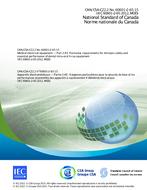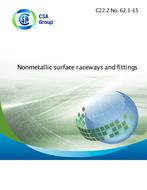Preface
This is the second edition of CSA Z605, Mobility aid securement and occupant restraint (MASOR) systems for motor vehicles. It supersedes previous editions published in 2003 and 1995. This edition includes updates to definitions and to requirements for construction, marking, test procedures, performance, and crashworthiness of MASOR systems used with mobility aids in motor vehicles intended for that purpose. Non-mandatory, recommended practice for MASOR systems is covered in Annex B. Requirements for public transportation motor vehicles with a gross vehicle weight rating (GVWR) of less than 7000 kg (15 500 lb), equipped for transporting mobility aids, are contained in CSA D409, Motor Vehicles for the Transportation of Persons with Physical Disabilities. It is the intent that CSA D409 be used in conjunction with this Standard.
Scope
1.1 This Standard specifies a) general design requirements; b) performance requirements; c) test methods; d) requirements for product marking and labelling; and e) requirements for instructions and warnings for MASOR systems intended for use with forward-facing mobility aids occupied by children and adults with mass of 22 kg (48 lb) or greater, travelling in personally licensed and public motor vehicles having a gross vehicle weight rating (GVWR) of less than 7000 kg (15 500 lb). 1.2 The requirements of this Standard apply to MASOR systems that use all types of mobility aid securement systems, including four-point strap-type systems, as well as docking and clamping devices. 1.3 This Standard places particular emphasis on the requirements for the dynamic performance of MASOR systems in a 48 km/h (30 mph), 20 g (44 lb) frontal impact and does not determine suitability for side or rear vehicle impact, or impacts of lesser or higher magnitude. It also specifies test procedures and performance requirements regarding a) webbing slippage at adjustment devices for strap-type securement systems; and b) partial but ineffective engagement of restraints and their components that could be perceived to be effectively engaged. 1.4 While the primary focus of this Standard is MASOR systems that are packaged by the manufacturer as a complete system, manufacturers of MASOR systems components and subassemblies may certify their equipment as being in compliance with this Standard provided that a) the subassemblies and components intended to be used together to create a MASOR system meet all the appropriate requirements of this Standard; and b) the separately sold components and subassemblies are provided with instructions in accordance with Clause 5.6, where the word “compatible” means tested together to comply with this Standard. 1.5 The values given in SI units are the units of record for the purposes of this Standard. The values given in parentheses are for information and comparison only. 1.6 In this Standard, “shall” is used to express a requirement, i.e., a provision that the user is obliged to satisfy in order to comply with the standard; “should” is used to express a recommendation or that which is advised but not required; and “may” is used to express an option or that which is permissible within the limits of the Standard. Notes accompanying clauses do not include requirements or alternative requirements; the purpose of a note accompanying a clause is to separate from the text explanatory or informative material. Notes to tables and figures are considered part of the table or figure and may be written as requirements. Annexes are designated normative (mandatory) or informative (non-mandatory) to define their application.
Product Details
- Edition:
- 2nd
- Published:
- 06/01/2016
- ISBN(s):
- 9781488303890
- File Size:
- 1 file , 2.4 MB
- Product Code(s):
- 2424648, 2424528, 2424528, 2424528


